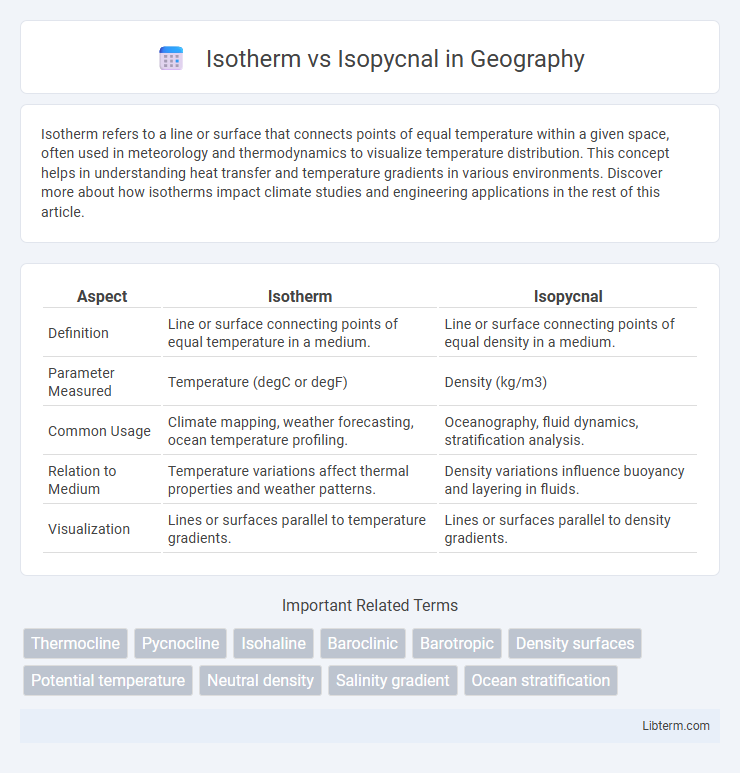Isotherm refers to a line or surface that connects points of equal temperature within a given space, often used in meteorology and thermodynamics to visualize temperature distribution. This concept helps in understanding heat transfer and temperature gradients in various environments. Discover more about how isotherms impact climate studies and engineering applications in the rest of this article.
Table of Comparison
| Aspect | Isotherm | Isopycnal |
|---|---|---|
| Definition | Line or surface connecting points of equal temperature in a medium. | Line or surface connecting points of equal density in a medium. |
| Parameter Measured | Temperature (degC or degF) | Density (kg/m3) |
| Common Usage | Climate mapping, weather forecasting, ocean temperature profiling. | Oceanography, fluid dynamics, stratification analysis. |
| Relation to Medium | Temperature variations affect thermal properties and weather patterns. | Density variations influence buoyancy and layering in fluids. |
| Visualization | Lines or surfaces parallel to temperature gradients. | Lines or surfaces parallel to density gradients. |
Introduction to Isotherms and Isopycnals
Isotherms represent lines on a map or chart that connect points of equal temperature, essential for analyzing thermal patterns in oceanography and meteorology. Isopycnals are contours linking points of equal density, crucial for understanding fluid stratification and mixing processes in aquatic environments. Both isotherms and isopycnals provide foundational insights into temperature distribution and density gradients, influencing ocean circulation and climate dynamics.
Defining Isotherms: Meaning and Importance
Isotherms are lines on a map or chart connecting points of equal temperature, crucial for visualizing thermal gradients in meteorology and oceanography. They help identify temperature distribution patterns, enabling better weather forecasting and climate analysis. Understanding isotherms is essential for studying heat transfer processes, ocean circulation, and atmospheric dynamics.
Defining Isopycnals: Concept and Significance
Isopycnals are surfaces or lines within a fluid body, such as the ocean or atmosphere, where the density remains constant. Understanding isopycnals is crucial for studying fluid dynamics, as they help identify the stratification and mixing of water masses or air layers. These surfaces influence ocean circulation, heat transport, and the distribution of nutrients, playing a central role in climate systems and marine ecosystems.
Physical Properties Traced by Isotherms
Isotherms represent lines of constant temperature in a fluid, crucial for understanding thermal gradients and heat distribution in oceans or the atmosphere. They trace physical properties such as heat content, thermal stratification, and influence on density-driven currents. Unlike isopycnals, which follow lines of constant density, isotherms specifically highlight variations in temperature that affect energy transfer and thermohaline circulation.
Physical Properties Traced by Isopycnals
Isopycnals trace surfaces of constant density, revealing critical physical properties such as stratification, water mass boundaries, and mixing processes in the ocean. Unlike isotherms, which represent constant temperature, isopycnals integrate temperature and salinity effects, providing a more accurate depiction of water column stability and flow patterns. Understanding isopycnal distribution aids in identifying thermohaline circulation and nutrient transport pathways essential for marine ecosystems.
Applications of Isotherms in Oceanography
Isotherms in oceanography play a crucial role in mapping temperature distribution, which helps identify water masses and detect ocean currents such as the Gulf Stream. These temperature contours assist in understanding heat exchange processes between the ocean and atmosphere, influencing climate models and weather prediction accuracy. Isotherm analysis also supports marine ecosystem studies by revealing thermal habitats that affect species distribution and migration patterns.
Applications of Isopycnals in Oceanography
Isopycnals, lines of constant density, are crucial in oceanography for analyzing ocean stratification and mixing processes. They help identify water masses, track nutrient transport, and study internal waves and circulation patterns. Understanding isopycnal surfaces improves predictions of ocean dynamics and climate-related changes.
Key Differences Between Isotherms and Isopycnals
Isotherms represent lines of constant temperature in a fluid, primarily used to analyze thermal variations, while isopycnals indicate lines of constant density, essential for studying fluid stratification and mixing. Isotherms are influenced by heat exchange and solar radiation, whereas isopycnals depend on temperature, salinity, and pressure gradients affecting seawater density. Understanding these differences aids oceanographers and meteorologists in interpreting temperature-driven phenomena versus density-driven fluid dynamics.
Visualization and Mapping Techniques
Isotherm visualization utilizes temperature contour mapping to display lines of constant temperature, often represented through gradient color scales to enhance thermal distribution analysis. Isopycnal mapping involves plotting surfaces or contours of equal density in oceanographic data, typically requiring 3D modeling tools that integrate salinity, temperature, and pressure variables for accurate density profiling. Advanced Geographic Information Systems (GIS) and remote sensing technologies facilitate high-resolution mapping, allowing precise interpretation of thermohaline structures in marine environments.
Conclusion: Choosing Between Isotherm and Isopycnal Analyses
Selecting between isotherm and isopycnal analyses depends on the specific oceanographic parameter of interest, with isotherms representing lines of constant temperature and isopycnals delineating surfaces of equal density. Isopycnal analyses provide a more accurate framework for studying water mass movement and mixing because density governs buoyancy and stratification, crucial for understanding ocean circulation. For thermal studies or temperature-dependent biological processes, isotherm analyses remain invaluable, but integrating both approaches often yields comprehensive insights into marine dynamics.
Isotherm Infographic

 libterm.com
libterm.com